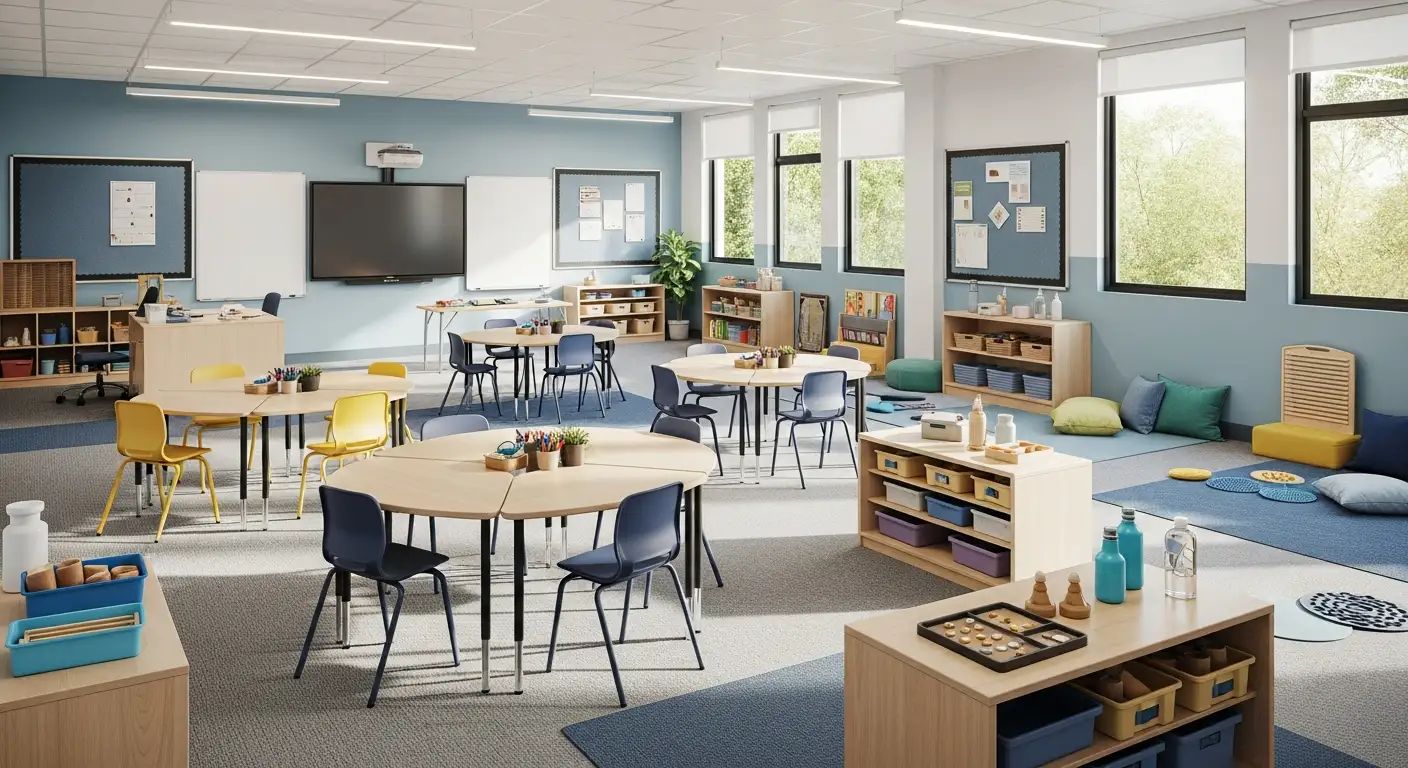Exploring the Foundations of Stimulus Generalization in Therapy
Stimulus generalization is a fundamental concept in psychology and behavioral therapy that explains how responses learned in one context can extend to similar stimuli and situations. This phenomenon plays a crucial role in the effectiveness of therapeutic interventions, particularly in applied behavior analysis (ABA). Understanding the mechanisms, applications, and strategies associated with stimulus generalization helps clinicians design programs that foster meaningful and long-lasting behavioral improvements. This article delves into the core principles, historical background, and practical considerations of stimulus generalization, providing a comprehensive overview for practitioners, students, and anyone interested in the science of behavior change.
Understanding the Concept of Stimulus Generalization
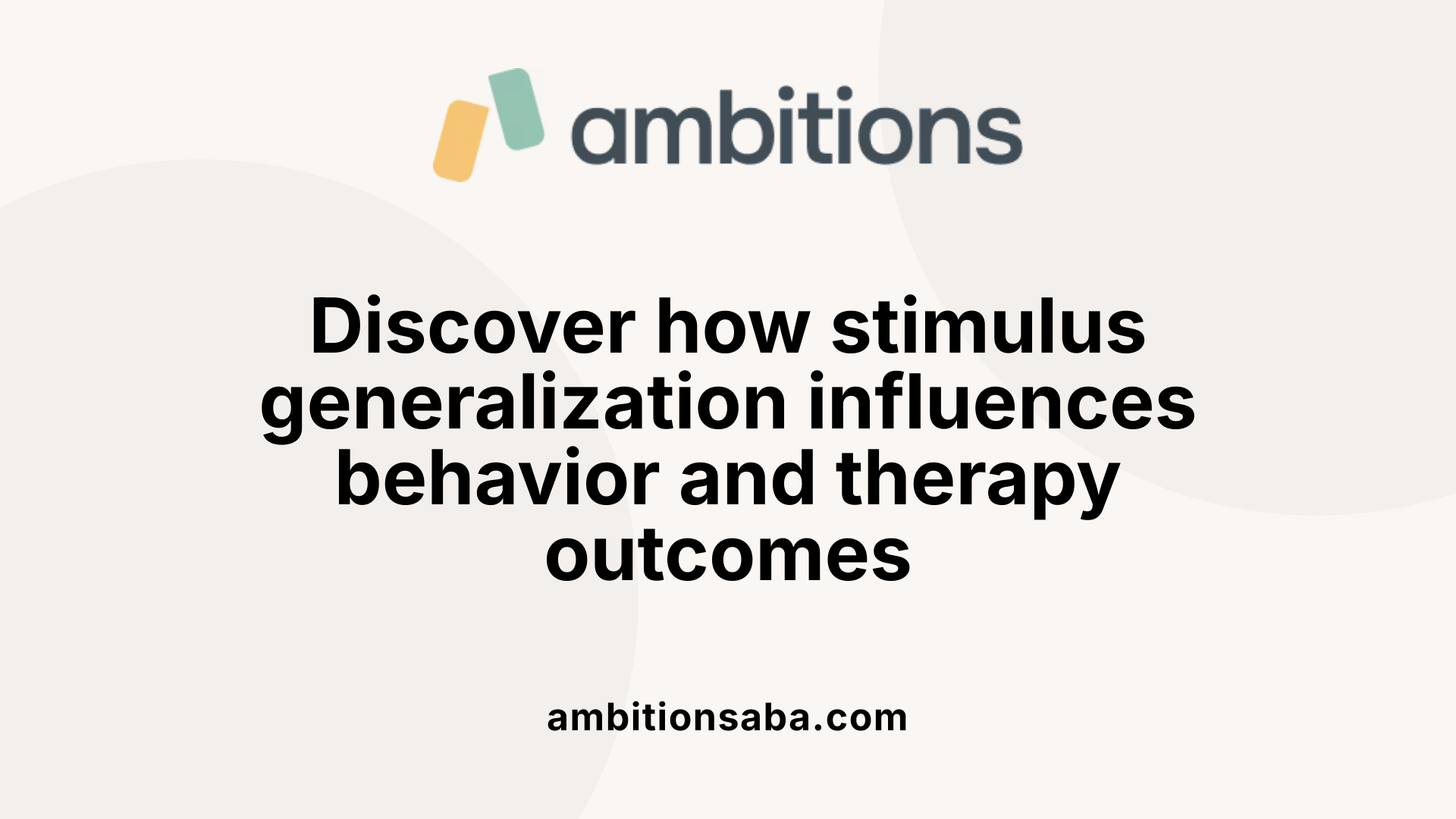
What is stimulus generalization and why is it important in therapy?
Stimulus generalization refers to the tendency for a learned response to be triggered by stimuli that resemble the original conditioned stimulus. This phenomenon occurs in both classical and operant conditioning processes. In practical terms, it means that once a person or animal learns to respond in a certain way to one stimulus, they may also respond similarly to new, but related stimuli.
This concept plays a significant role in therapeutic settings, particularly in applied behavior analysis (ABA). It ensures that skills or behaviors learned during structured therapy are transferred effectively to real-world situations. For example, a child who learns to say "hello" during therapy should also greet others in less structured environments such as at home or in the community.
To promote generalization, practitioners often create specific plans that include practicing skills across different settings, involving family members, and using naturalistic teaching methods. These strategies help individuals apply their skills broadly, ensuring that the benefits of therapy are sustained beyond the clinical setting.
Overall, stimulus generalization enhances the practicality and durability of behavioral interventions, making it a crucial aspect of effective therapy. It enables individuals to function more independently and confidently in diverse environments, which ultimately leads to better long-term outcomes.
The Role of Stimulus Generalization in Therapy and Skill Transfer
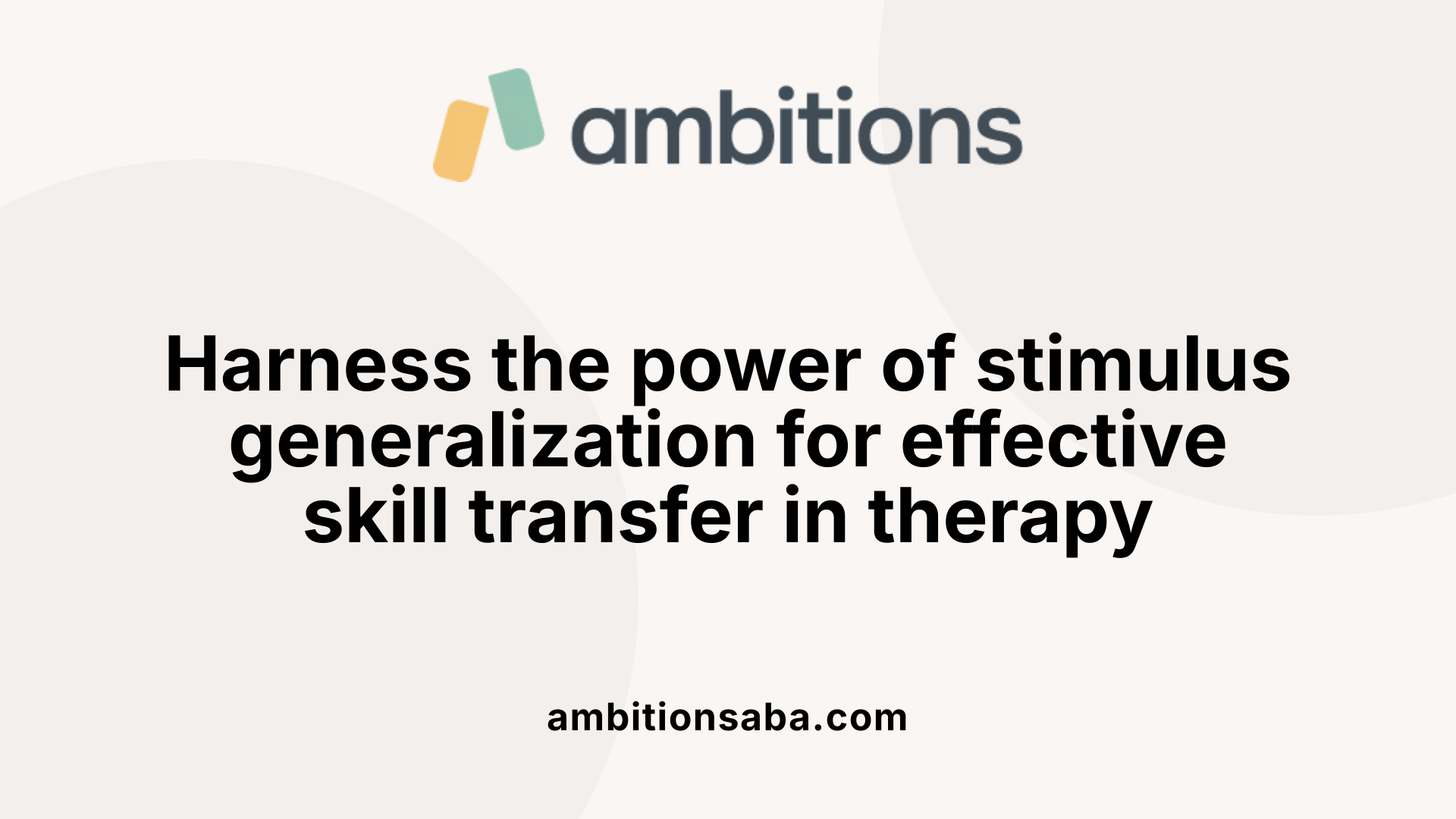
How is stimulus generalization utilized in behavioral therapy, especially ABA?
In applied behavior analysis (ABA), stimulus generalization plays a pivotal role in making therapeutic outcomes meaningful and long-lasting. Therapists intentionally teach skills across a variety of contexts, settings, and with different exemplars to encourage the transfer of learned behaviors to everyday life.
Practitioners reinforce correct responses when presented with diverse stimuli that share similar features, such as different toys, locations, or social partners. For example, if a child learns to say “hello” during therapy sessions, ABA strategies aim to extend this greeting to family members, teachers, and peers. This is achieved by using multiple examples, involving different people, and practicing in various environments.
Efforts to promote generalization include instructing caregivers and teachers to replicate training across settings, which helps embed the skill into daily routines. Structured approaches like naturalistic teaching, role-playing, and task variation are also used.
Overall, stimulus generalization ensures that skills are not confined to the therapy setting but are usable in real-world situations, such as at home, school, or in community environments. This approach boosts independence and helps individuals apply what they learn for more functional behavior changes.
Can you provide examples of stimulus generalization in therapeutic settings?
Stimulus generalization manifests when behaviors learned in therapy extend beyond the original teaching environment to other settings and stimuli that are similar.
A common example is a child who has learned to follow instructions during a therapy session. This child can use those learned skills at home or in school without additional training, demonstrating successful generalization.
In trauma or anxiety therapy, individuals might respond fearfully not just to the originally feared object, like a specific dog, but to other similar breeds or animals. This broad fear response indicates generalization of the fear response.
Another case is in social skills training; a person taught to make eye contact and shake hands during therapy may generalize these behaviors to less structured environments, such as social gatherings or workplace interactions.
In speech therapy or language acquisition, children might learn to label a specific object, such as a ball, and then apply this label to similar items like a balloon or an orange, demonstrating response generalization.
These examples show how generalization enhances the practical impact of therapy by enabling responses to be effective in natural, everyday situations.
Strategies for promoting stimulus generalization in ABA and therapy
Promoting stimulus generalization can be achieved through a variety of targeted strategies. One approach involves varying stimuli during training—using different settings, materials, and social partners—to help learners apply skills broadly.
Integrating naturalistic teaching methods and ensuring behaviors are reinforced across multiple contexts are also effective. Role-playing, modeling, and using real-life scenarios help embed skills in everyday environments.
Involving family members and caregivers in training is crucial. They can reinforce skills at home and in community settings, which supports consistency and transfer.
Gradually fading prompts and cues, practicing in different locations, and incorporating natural reinforcement are techniques that help solidify behaviors across diverse environments.
Implementing a structured generalization plan, which maps out specific steps and strategies, ensures systematic exposure and reinforcement.
Continuous assessment and data collection are essential for monitoring progress and adjusting strategies to maximize generalization.
Overall, the combination of diverse stimuli, naturalistic practices, caregiver involvement, and ongoing evaluation facilitates the broad application of learned behaviors, leading to more meaningful and lasting outcomes.
| Strategy Type | Description | Example |
|---|---|---|
| Stimulus Variation | Using different but similar stimuli during training | Practicing greetings with different people in various settings |
| Naturalistic Training | Embedding learning in real-life contexts | Teaching shopping skills during actual shopping trips |
| Caregiver Involvement | Training family or staff to reinforce skills | Having parents prompt responses at home |
| Prompt Fading | Gradually reducing prompts to encourage independence | Moving from physical prompts to visual cues |
| Data Monitoring | Collecting ongoing data to adjust strategies | Tracking skill use in different environments |
Stimulus generalization, when well-managed, enhances the likelihood that behaviors acquired in therapy will be effective and sustainable across all areas of an individual's life, making it an essential focus in clinical and educational interventions.
Historical Foundations and Theoretical Background
What is stimulus generalization?
Stimulus generalization is a phenomenon where an organism responds to stimuli that are similar but not identical to a conditioned stimulus (CS). After a subject has been conditioned to respond to a specific stimulus, such as a loud sound, it may also respond to quieter sounds or noises with similar characteristics. This response transfer allows for adaptive behaviors across similar situations but can sometimes lead to inappropriate reactions.
How does stimulus generalization occur in classical and operant conditioning?
In classical conditioning, stimulus generalization occurs when a conditioned response (CR), like salivation in Pavlov’s dogs, is triggered by stimuli resembling the original CS. For example, dogs may salivate to similar sounding bells.
In operant conditioning, it manifests when behaviors learned in one context are transferred to similar settings or stimuli. For example, a child who learns to say 'dog' upon seeing a specific breed may also say 'dog' to similar breeds or even stuffed animals.
Examples illustrating stimulus generalization
- Fear of all dogs after a bite from one breed.
- Preference for similar beverage brands due to packaging or taste.
- Speech or behavior responses that extend across similar social situations.
Mechanisms and measurements
The gradual change in response strength to stimuli that vary in similarity is described by the generalization gradient. Typically, responses are strongest to stimuli most similar to the original CS and weaken as stimuli become less similar.
Peak shift is a related phenomenon where, after discrimination training, the strongest response shifts away from the original CS towards a stimulus that is more distinguishable.
Role of stimulus discrimination and the importance of managing generalization
While generalization can be beneficial in applying learned behaviors across varied contexts, it can also pose problems when individuals need to differentiate stimuli. For example, in therapy for phobias, teaching stimulus discrimination helps individuals to respond only to specific stimuli and avoid overgeneralization.
Applications in Applied Behavior Analysis (ABA)
ABA practitioners actively work to promote stimulus generalization to ensure skills transfer from therapy to real-world environments. Strategies include using varied stimuli, involving caregivers, and practicing skills in multiple settings.
Creating a structured plan for generalization, continuously assessing progress, and adjusting strategies accordingly are vital components of effective ABA programs.
Historical origins of stimulus generalization
The roots of stimulus generalization trace back to Ivan Pavlov's early 20th-century experiments. Pavlov demonstrated that dogs would salivate not only to the specific tone he conditioned but also to stimuli similar to the tone, such as different sounds. This foundational work was published in 1927 and highlighted how responses could extend across similar stimuli.
Building upon Pavlov’s experiments, psychologists like John B. Watson showed that fear could generalize, as in the Little Albert experiment, where fear of a white rat extended to rabbits and dogs. B.F. Skinner and Edward Thorndike further expanded understanding within operant and instrumental conditioning paradigms, illustrating how stimuli elicit responses across various contexts.
Research on the mechanisms involved in stimulus generalization introduced concepts like the generalization gradient, showing how response strength varies with stimulus similarity. The peak shift phenomenon was also described, emphasizing how discrimination training can cause responses to shift away from the original stimulus.
Together, these studies established stimulus generalization as a central concept in behavioral psychology, providing insights into learning, emotional responses, and behavioral transfer across situations.
Strategies to Improve Generalization Outcomes
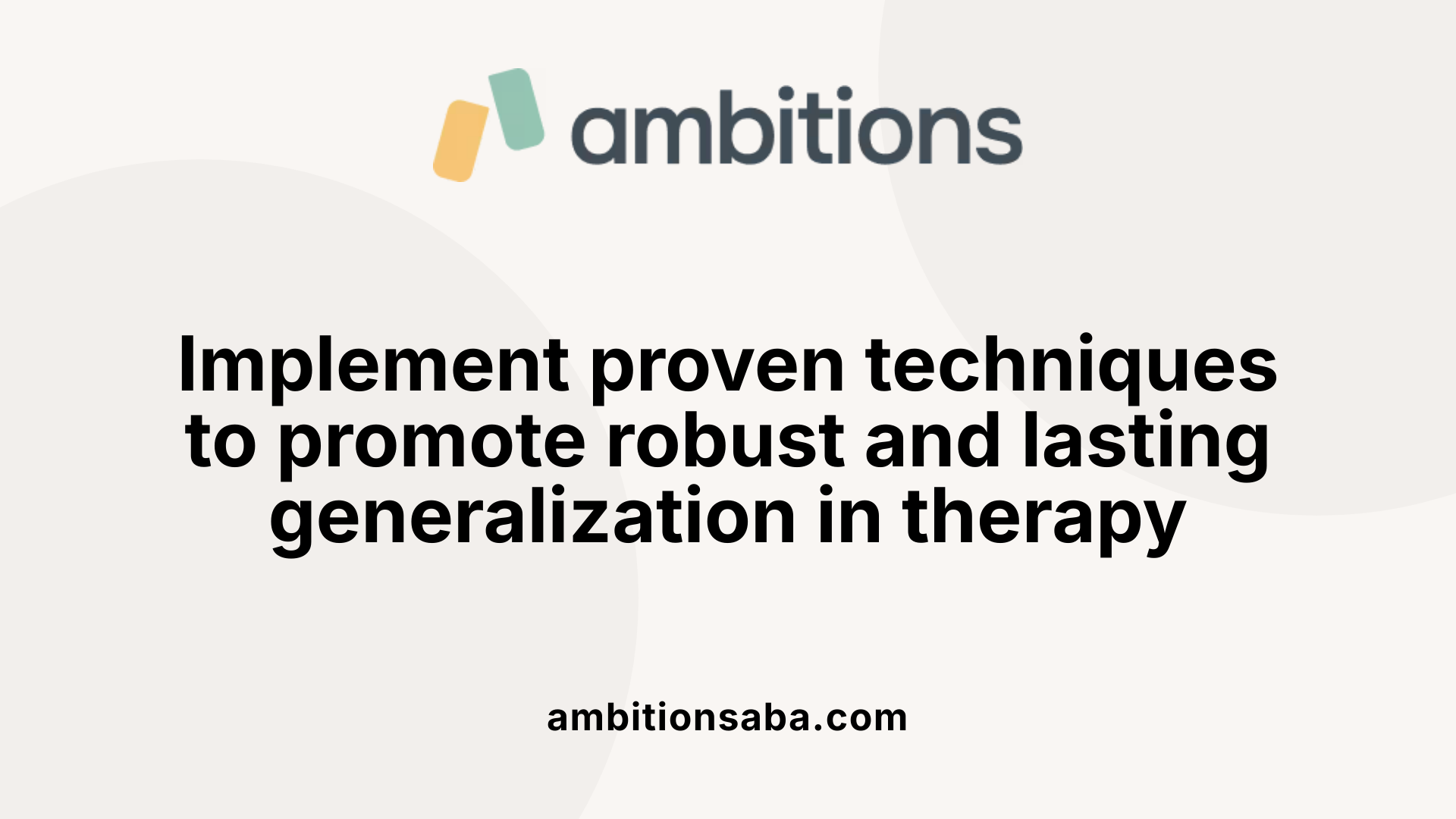
What strategies are used in training to promote stimulus generalization and improve therapeutic outcomes?
Promoting stimulus generalization is essential for ensuring that learned behaviors transfer effectively across different environments and situations. In applied behavior analysis (ABA), several methods are employed to enhance generalization.
One fundamental strategy involves training in diverse settings. This means practicing skills in different environments such as home, school, community, and natural social situations. For example, a child learning to greet people may practice in various locations and with different individuals to strengthen generalization.
Naturalistic teaching methods are also highly effective. Techniques like incidental teaching or opportunistic teaching embed learning within everyday activities and interactions. Behavior chaining, which connects smaller learned steps into a whole skill, helps children adapt behaviors in natural contexts.
Involving caregivers and educators is another crucial component. Training family members and teachers ensures consistency and provides multiple opportunities for reinforcement outside the therapy setting. This collaboration supports the child's ability to generalize skills broadly.
Ongoing monitoring and data collection are vital to assess how well behaviors are generalizing. Adjustments to intervention plans—such as varying stimuli, reinforcement schedules, and response prompts—are made based on continuous observations. This dynamic approach maximizes the likelihood of maintaining and expanding the learned behaviors.
Other strategies include using social stories, which affirms appropriate responses in various social situations, role-playing exercises for practicing skills in different scenarios, and behavioral momentum techniques, which help reinforce successes and build confidence.
Overall, these combined efforts contribute to more robust and sustainable behavioral improvements by ensuring that individuals can apply skills flexibly across multiple contexts and over time.
Mechanisms and Related Concepts in Stimulus Generalization
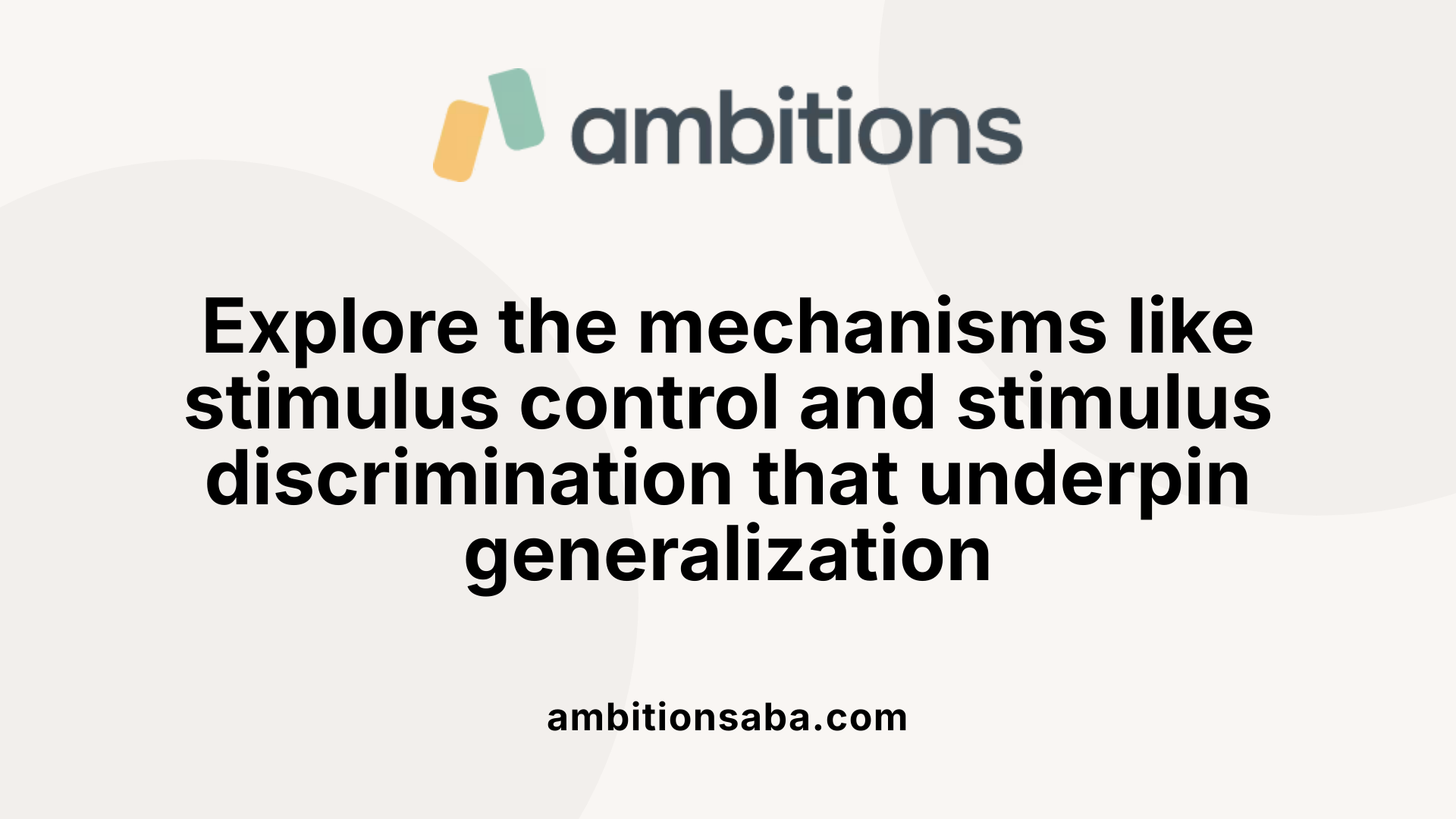
What roles do stimulus control, response generalization, and stimulus equivalence play?
Stimulus control is fundamental in learning processes, where specific behaviors are more likely to occur in the presence of particular stimuli. Through reinforcement, a behavior becomes closely associated with a stimulus, establishing a strong stimulus control. For instance, in applied behavior analysis (ABA), a child may learn to say 'hello' specifically when greeted by a teacher, demonstrating stimulus control.
Response generalization involves the transfer of a learned response to new but related stimuli or situations. If a child learns to greet with a handshake in therapy, they might later extend this greeting to other social contexts without additional training.
Stimulus equivalence is a related concept where different stimuli are mentally linked, and responding to one stimulus automatically evokes responses to others in its equivalence class. This can include symbols, objects, and words that are taught as being related, promoting efficient learning.
Here's a table summarizing their roles:
| Concept | Description | Example |
|---|---|---|
| Stimulus control | Behavior more likely in presence of specific stimuli | Child responds to 'doorbell' with a wave |
| Response generalization | Responding similarly to related stimuli | Saying 'cat' to both live and stuffed animals |
| Stimulus equivalence | Different stimuli treated as same | Recognizing 'dog' in words and pictures |
Understanding how these mechanisms work helps in designing effective interventions, whether by strengthening desired stimulus control or promoting response and stimulus generalization.
How does stimulus generalization differ from stimulus discrimination?
Stimulus generalization and stimulus discrimination are two sides of the same learning coin.
Stimulus generalization occurs when an organism responds to stimuli that are similar to the original conditioned stimulus. This broad response pattern allows the organism to react to a variety of stimuli without needing separate training for each one. For example, after being conditioned to fear a specific white rat, a child might also feel fear towards rabbits or white masks due to their visual similarities.
Conversely, stimulus discrimination involves learning to distinguish between different stimuli and respond selectively. During discrimination training, responses are reinforced only for the target stimulus, while responses to other similar stimuli are not reinforced and thus diminish. For example, a dog trained to sit when hearing a specific tone may ignore other sounds.
The main differences are summarized:
| Aspect | Stimulus Generalization | Stimulus Discrimination |
|---|---|---|
| Response scope | Broad, across similar stimuli | Narrow, specific to trained stimulus |
| Learning focus | React for similar stimuli | Differentiate stimuli to respond appropriately |
| Techniques used | None, natural development | Reinforcement only for target stimulus |
| Example | Fear response spreading from one dog to all | Responding only to a specific bell sound |
Knowing when to promote generalization or discrimination is essential in therapies and training to either broaden responses for functional adaptability or refine responses for accuracy.
Summing Up the Significance of Stimulus Generalization
Stimulus generalization stands as a cornerstone in the science of behavior change and therapy, providing the bridge between learned responses in controlled settings and their successful application across diverse real-world environments. Its understanding rooted in classical and operant conditioning research—originating from the pioneering work of Pavlov—is critical for designing effective interventions. By fostering the appropriate transfer of skills, minimizing maladaptive spread of responses, and distinguishing between generalization and discrimination, practitioners can optimize therapeutic outcomes. Employing a variety of strategies, from naturalistic teaching to caregiver involvement, enhances the durability of learned behaviors and supports independence. As research continues to evolve, the careful application and ongoing assessment of stimulus generalization principles remain essential to advancing behavioral sciences and improving the lives of individuals with behavioral challenges.
References
- What Is Stimulus Generalization in Psychology? - Verywell Mind
- 5.1 Stimulus Discrimination and Generalization - Learning - Fiveable
- Types of Generalization in ABA
- Stimulus Generalization: Psychology Definition, History & Examples
- Stimulus Generalization | Definition & Examples - Lesson - Study.com
- How Does Stimulus Generalization Work in ABA Therapy?
- What Is Stimulus Generalization? - EDS Learning Institute


